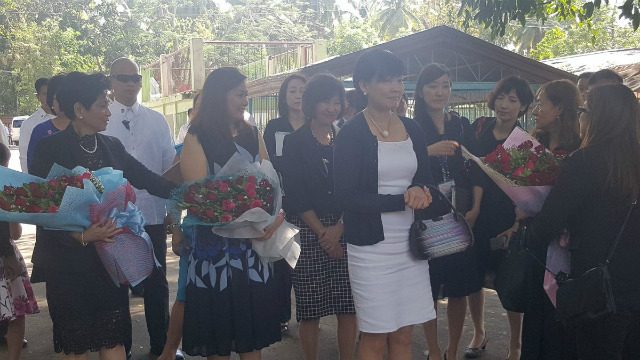SUMMARY
This is AI generated summarization, which may have errors. For context, always refer to the full article.

DAVAO CITY, Philippines – Philippine President Rodrigo Duterte’s common-law wife Honeylet Avanceña took on a First Lady role as she accompanied Mrs Akie Abe to a Japanese cemetery on Friday, January 13.
Avanceña was the lead escort of Mrs Abe, wife of Japanese Prime Minister Shinzo Abe, to Mintal Cemetery where around 300 of Davao City’s first Japanese residents are buried.
Avanceña, clad in a black dress with blue and white floral prints, walked beside Mrs Abe, clad in a white dress and dark blue cardigan.
Aside from Avanceña, Mrs Abe was accompanied by Bertola Medialdea, wife of Executive Secretary Salvador Medialdea, and Yuko Ishikawa, wife of Japanese Ambassador Kazuhide Ishikawa.
Escorting the spouse of a foreign head of government is a task typically given to a First Lady.
Avanceña accompanied Mrs Abe as the Japanese prime minister was on a two-day official visit to the Philippines, which included a trip to Duterte’s home in Davao City.
‘Long-time partner’
Previously, Avanceña was with Duterte at the vin d’honneur and was also present at his inauguration, although not in the main program.
Avanceña so far has not officially assumed the role of First Lady. She is referred to as Duterte’s “long-time partner.”
At the cemetery, Mrs Abe said prayers in front of the Tower of Japanese Residents Who Passed Away and the Muyu Monument.
Avanceña could be heard explaining to Mrs Abe that Duterte had ordered the construction of the Muyu Monument 3 years ago after he and Avanceña made a trip to Japan.
On the monument is carved the words, “Every human being is my brother, my sister, my child” and “The person who loved the Philippines and loved Davao is now here.”
Mintal Cemetery was built in 1910 by Ohta Kyouzaburo, the Japanese owner of vast abaca plantations that drew Japanese workers to Davao City.
After the war, several Japanese graves were dug up by Filipinos looking for treasure.
The Muyu Monument serves as as a marker for those graves. – Rappler.com
Add a comment
How does this make you feel?
There are no comments yet. Add your comment to start the conversation.